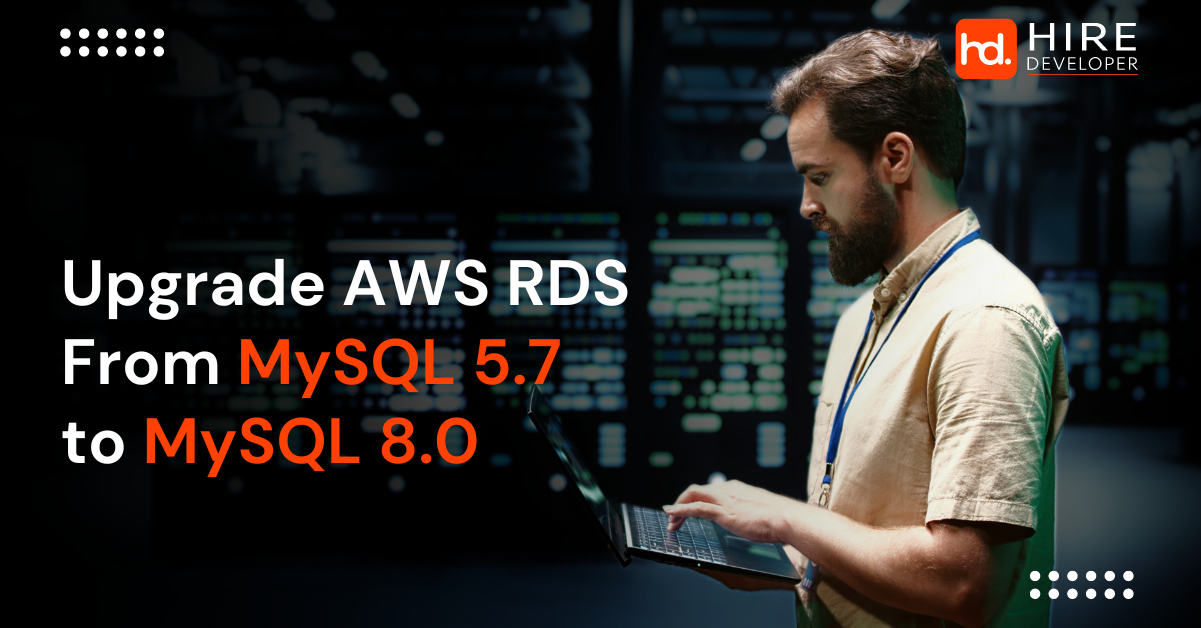In today’s rapidly evolving tech landscape, staying current is no longer a choice—it’s a necessity. Amazon Web Services (AWS) recently announced a crucial update: transitioning Amazon RDS MySQL from version 5.7 to version 8.0. This upgrade introduces many new features and enhancements aimed at improving business database management. However, it’s important to note a significant deadline: standard support for MySQL versions below 8.0 ceased in February 2023. While AWS currently offers extended support at an increased cost, this option will only be available for a limited time.
Announcement: End of Support for MySQL 5.7
AWS’s decision to discontinue support for MySQL 5.7 and earlier versions is a pivotal moment. It means that businesses relying on MySQL 5.7 will no longer receive updates, security patches, or assistance from AWS. Understanding the implications of this change is crucial for companies to ensure the security, stability, and efficiency of their database systems.
Why MySQL 8.0 on AWS RDS Is Essential
- Enhanced Performance: MySQL 8.0 improves performance such as an upgraded data dictionary and faster JSON processing. These enhancements result in smoother-running applications and heightened user satisfaction.
- Improved Security: Security is paramount in today’s digital landscape. MySQL 8.0 introduces enhanced security features, including improved default settings and robust access controls, strengthening businesses against cyber threats.
- Scalability and Availability: Designed to handle larger datasets and allocate resources more efficiently, MySQL 8.0 offers advanced tools for ensuring high availability, such as Group Replication and InnoDB Cluster. This scalability and reliability make MySQL 8.0 an optimal choice for businesses of all sizes.
Consequences of Delaying the Upgrade
Continuing to use MySQL 5.7 post-deadline poses risks. Without AWS support, businesses may face security vulnerabilities, performance degradation, and compliance issues. Moreover, sticking with outdated software inhibits innovation—a significant disadvantage in today’s competitive landscape. To provide a comprehensive understanding of delaying the upgrade process, it’s important to consider the following:
- Extended Support Costs: With the deadline to update already passed, AWS is now offering extended support for MySQL 5.7 at an additional cost. This cost may be significantly higher than standard support fees.
- Charges Breakdown: For the first year of extended support, AWS will impose an initial fee, typically higher than in subsequent years. Charges may vary depending on the level of support required. In the second and third years, costs may decrease incrementally but remain higher than standard support fees. The charges for Amazon RDS Extended Support vary per region and are a per vCPU per hour charge. For example, an Amazon RDS for MySQL database running on a db.r5.large instance in the US West (Oregon) region has 2 vCPUs. To calculate the charges, navigate to the Amazon RDS Extended Support pricing page for the respective database to determine the vCPU per hour pricing for both the first two years, and then the pricing for the third year. In this case, the first-year charge is $ .100 per vCPU hour*365 days*24 hours*2 vCPUs = $1,752. The second-year charge is identical to the first at $1,752. For the third year, $ .200*365*24*2 = $3,504. The total of three years is $7,008 for all three years. This example assumes that the database was not upgraded during the time frame. The number of hours is calculated on running 24/7 during the entire year, and this is a single AZ configuration.
- Considerations for Extended Support: It’s essential to note that extended support for MySQL 5.7 will only be available for a limited period, typically three years. After this period, businesses may face even higher costs for continued support. Upgrading to MySQL 8.0 now presents a more sustainable solution. “Hire a Developer” can facilitate this transition efficiently with the expertise of their experienced team.
Let Hire Developer’s experienced AWS Expert team will guide you through this transition efficiently.
Smooth Transition with Hire a Developer
At Hire a Developer, we understand the importance of staying ahead in technology. Our team of AWS experts is prepared to assist you in smoothly transitioning from MySQL 5.7 to MySQL 8.0.
Key Steps for a Successful Upgrade
- Cost Implications and Optimization Strategies: Consider potential changes in pricing models or licensing fees and explore optimization strategies post-upgrade to maximize cost-effectiveness.
- Data Migration Best Practices: Prioritize data integrity and compatibility testing during the migration process to minimize downtime.
- Compatibility and Application Testing: Thoroughly test applications post-upgrade to ensure seamless functionality and validate compatibility with third-party integrations.
- Backup and Disaster Recovery Preparedness: Maintain robust backup and disaster recovery mechanisms throughout the upgrade process to safeguard against data loss or system failures.
- Customer Support and Resources: Utilize available customer support channels, documentation, and resources provided by AWS to navigate the upgrade process effectively.
- Regulatory Compliance Considerations: Assess the implications of the upgrade on regulatory compliance requirements and implement necessary measures to remain compliant.
Take Action Now
With the deadline already passed, proactive action is imperative. Upgrading to MySQL 8.0 offers improved performance, enhanced security, and scalability. Don’t wait until the last minute—reach out to Hire a Developer today to ensure a smooth transition and stay ahead of the curve.
Embrace Innovation and Stay Ahead
Transitioning from MySQL 5.7 to 8.0 is more than just an upgrade—it’s a strategic move to harness the full potential of your database infrastructure and maintain competitiveness in today’s market. With Hire a Developer by your side, the transition becomes a seamless opportunity for growth and innovation. Hire Now

